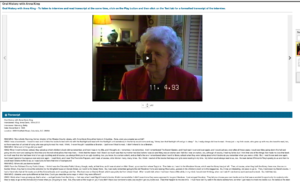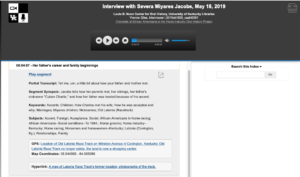Case Study 9.3: Oral History Metadata Synchronizer—A Transcript Solution
In some scenarios, it may prove difficult to provide synchronized access to transcripts and media materials. For instance, in 2016, a CONTENTdm user from Richland Library remarked on the difficulty involved in providing seamless access to both oral histories and transcripts—particularly for institutions with OCLC-hosted systems. To avoid using a self-hosted plan, the Richland Library opted to post both a plain-text rendition of any given interview in the transcript element of the metadata section below each video. The library added a note instructing users to click the play button and follow along in the transcript. See, for instance, the Oral History with Anna King, which is screenshotted below with a partial transcript.

A project at the University of Kentucky (UK) Libraries, the Oral History Metadata Synchronizer (OHMS), addresses concerns about integration of transcripts and A/V content. OHMS provides a time-correlated transcript within its media player and indexed access to the content of a particular piece of audio or video. GPS information and links may also be embedded at appropriate places within the transcript. This interview with Severa Miyars Jacobs provides a view of the OHMS player in practice.

OHMS and the Richland Library discussion highlight the need for testing usability even as you begin adding accessibility measures like captions and transcripts to the materials you manage.
